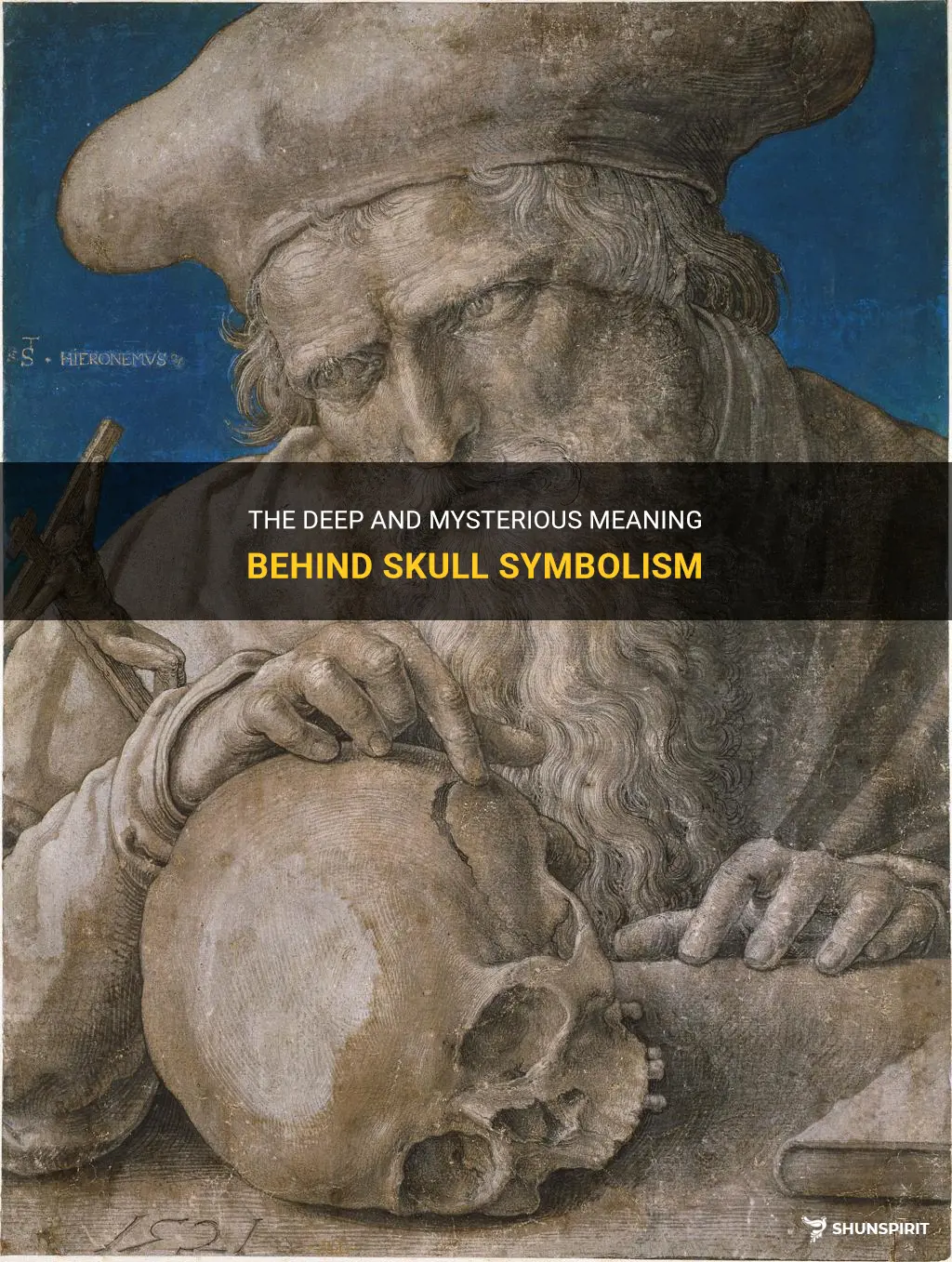
The skull, an ancient symbol that has intrigued and fascinated humans for centuries. This bone structure, once a vessel of life, is now associated with death and mortality. Yet, beyond its grim connotations, the skull holds a wealth of symbolism and meaning across various cultures and time periods. From being an emblem of danger and warning to serving as a reminder of the impermanence of life, the skull continues to captivate our collective imagination, beckoning us to explore its deep and enigmatic significance.
What You'll Learn
- What is the cultural significance of skulls and their symbolism in various societies?
- How has the meaning of skulls and their symbolism evolved throughout history?
- What are the different interpretations of skull symbolism in different religions and belief systems?
- How are skulls and their symbolism represented in art and popular culture today?
- Are there any specific skull symbols that are associated with certain meanings or messages?

What is the cultural significance of skulls and their symbolism in various societies?
The cultural significance of skulls and their symbolism vary greatly across different societies and civilizations around the world. Throughout history, skulls have held deep meanings and have been used to communicate a wide range of ideas and beliefs. From ancient times to contemporary culture, skulls continue to captivate our imaginations and provoke thought.
In many ancient civilizations, including the Aztec, Mayan, and Celtic cultures, skulls played a central role in religious rituals and ceremonies. These societies believed in the power of the skull as a symbol of life and death, creation and destruction, and the cycle of existence. The skull was seen as a powerful symbol that represented the human soul and the afterlife.
In Aztec culture, the skull, known as the calavera, was prominently featured in art, jewelry, and rituals. The Aztecs believed that the skull contained the essence of the human being, and they would often display skulls as trophies or offerings in their temples. Skulls were also used in the famous Day of the Dead celebrations, where they would be decorated with vibrant colors and adorned with flowers, symbolizing the joyful remembrance of the deceased.
Similarly, the ancient Celts revered the skull as a symbol of wisdom and spiritual power. They believed that the skull was the source of all knowledge and possessed the ability to communicate with other realms. The Celts would often display skulls in their sacred sites, believing that they could tap into the wisdom of their ancestors.
In modern society, the skull continues to hold significant cultural meaning. In Western culture, the skull is often associated with death and mortality. It is a potent symbol used in various art forms, such as literature, music, and fashion. The skull has become synonymous with rebellion and counterculture, often representing themes of rebellion, danger, and nonconformity.
Skulls have also entered popular culture through various symbols and motifs, such as the iconic Jolly Roger, the pirate flag with a skull and crossbones. This symbol evokes a sense of danger and rebellion, as pirates were known for their disregard of societal norms and laws.
Additionally, the skull has become widely popular in fashion and has been adopted as a fashion statement and an expression of alternative aesthetics. Skull motifs can be found on clothing, accessories, and jewelry, representing individualism, strength, and a connection to darker elements of life.
Furthermore, the skull has been used as a symbol of protest and political activism. In the late 20th century, the skull motif became associated with various counter-cultural movements, such as punk and goth subcultures. The skull was used as a visual representation of defiance against societal norms and an expression of individuality.
In conclusion, the cultural significance of skulls and their symbolism is multifaceted and varies across different societies. From ancient civilizations to contemporary culture, skulls have been used to represent a wide range of ideas, including life, death, wisdom, rebellion, and individualism. The enduring fascination with skulls is a testament to their powerful and universal symbolism throughout human history.
Decoding the Symbols and Meanings of Caterpillar Heavy Equipment
You may want to see also

How has the meaning of skulls and their symbolism evolved throughout history?
Skulls have long held a deep significance in various societies and cultures throughout history. They have been symbolic of both life and death, representing the duality of human existence. The symbolism of skulls has evolved and changed over time, often reflecting the beliefs and values of the societies they were a part of.
In ancient civilizations, the skull was seen as a powerful symbol of strength and resilience. It represented the seat of knowledge and wisdom, as well as the power of the mind. The Aztecs, for example, believed that the skull housed the soul and considered it to be a symbol of rebirth and regeneration. They often used skulls as decorative elements in their art and architecture, and during rituals, they would make offerings to the skulls of their ancestors.
In medieval Europe, the meaning of skulls took on a darker connotation. Skulls were commonly used as a reminder of mortality and the inevitability of death. They were prominently featured in artwork and literature of the time, serving as a memento mori, a Latin phrase meaning "remember you must die." This concept was meant to remind people to live a virtuous life and prepare for the afterlife.
During the Renaissance period, skulls began to be used as symbols of vanity and the transience of life. Artists such as Hans Holbein the Younger and Albrecht Dürer incorporated skulls into their artwork as a commentary on the fleeting nature of beauty and human achievements. These skull motifs were often depicted alongside symbols of wealth and luxury, emphasizing the emptiness and insignificance of material possessions in the face of death.
In more recent times, the symbolism of skulls has become a popular and mainstream motif in various subcultures. In the 20th century, skulls were adopted by different countercultural movements such as the punk and goth subcultures, often as a rebellious and anti-establishment symbol. The skull became associated with ideas of individuality, nonconformity, and a rejection of societal norms.
Today, the meaning of skulls is highly subjective and varies depending on the context. They can be seen as a symbol of danger and warning, as in the use of skull and crossbones in pirate imagery. Alternatively, skulls may also represent a celebration of life, as in the Mexican Day of the Dead festival, where they are used as a joyful symbol to honor deceased loved ones.
Overall, the symbolism of skulls has evolved throughout history, reflecting the beliefs, values, and cultural contexts of different societies. From representations of wisdom and rebirth to reminders of mortality and rebellion, the meaning of skulls has remained ever-changing, leaving room for personal interpretation and cultural significance.
Understanding the Symbols on Your Danby Air Conditioner Remote: A Guide
You may want to see also

What are the different interpretations of skull symbolism in different religions and belief systems?
Skull symbolism is present in various religions and belief systems throughout history. Although the interpretation may vary, it often represents themes of mortality, death, and the impermanence of life. Let's explore how different religions and belief systems interpret the symbolism of skulls.
In Christianity, the skull is often associated with Golgotha, the place where Jesus was crucified. According to tradition, Golgotha translates to "the place of the skull" in Hebrew. The presence of a skull symbolizes the victory of Christ over death, as his crucifixion and resurrection brought salvation to humanity. Christian artwork often depicts a skull beneath the cross to emphasize this triumph of life over death.
In Buddhism, skulls are seen as reminders of impermanence and the transient nature of life. They serve as a memento mori, reminding individuals of the inevitability of death and the importance of living a mindful existence. In Tibetan Buddhism, for example, skull cups are used in certain rituals to symbolize the impermanence of life, as well as to represent the "empty" nature of reality.
In Hinduism, skulls are associated with Lord Shiva, one of the major deities. Shiva is often depicted with a garland of skulls, known as a "munda mala," around his neck. This garland symbolizes the destruction of the ego and the transcendence of material attachments. It represents the cyclical nature of life and death, highlighting the idea that all things must eventually decay and make way for rebirth.
In ancient Celtic beliefs, skulls were seen as symbols of transformation and the cycle of life. They were associated with Samhain, the Celtic festival that marked the end of the harvest season and the beginning of winter. During this festival, skulls were used in rituals to honor deceased ancestors and to connect with the spirit world. The skulls represented the souls of the departed and the belief in the continuity of life beyond death.
In Mexican culture, skulls are prominently featured during the Day of the Dead, or Dia de los Muertos, a holiday that celebrates deceased loved ones. The colorful skull images, known as calacas or calaveras, are used as decorative motifs and represented on sugar skulls and other artistic expressions. Rather than symbolizing death itself, they symbolize the celebration of life and the belief that the dead are still a part of the community.
In summary, the interpretation of skull symbolism varies across different religions and belief systems. In Christianity, skulls represent the victory of life over death through the crucifixion and resurrection of Jesus. In Buddhism, skulls remind individuals of the impermanence of life and the importance of mindfulness. In Hinduism, skulls represent the cyclical nature of life and the transcendence of material attachments. In Celtic beliefs, skulls signify transformation and the connection with the spirit world. In Mexican culture, skulls symbolize the celebration of life and the remembrance of deceased loved ones. Ultimately, the symbolism of skulls provides a reminder of the transient nature of life and the importance of cherishing the present moment.
The Symbolic Meaning of Perfume as a Gift: Unraveling the Fragrant Significance
You may want to see also

How are skulls and their symbolism represented in art and popular culture today?
Skulls have been a prominent symbol throughout history, appearing in various forms of art and culture. They are often associated with death and mortality but have also come to symbolize rebellion, power, and even celebration. In today's world, skulls continue to be a popular motif in art and popular culture, representing a wide range of meanings and emotions.
One of the most recognizable representations of skulls in art is the iconic skull and crossbones symbol. This symbol is commonly associated with pirates and has become a popular motif in tattoos, clothing, and other forms of popular culture. The skull and crossbones are often seen as a symbol of adventure, rebellion, and a desire to live life on one's own terms.
Skulls are also commonly seen in various forms of contemporary art. Many artists use skulls as a way to explore themes of mortality, decay, and the fleeting nature of life. For example, Damien Hirst, a British artist, is known for his series of artworks featuring actual skulls encrusted with diamonds. These works blur the lines between life and death, beauty and decay, and challenge viewers to confront their own mortality.
In addition to fine art, skulls have also become a popular design element in various forms of popular culture, such as fashion, music, and film. Fashion designers often incorporate skull motifs into their designs, whether it be in the form of skull-shaped jewelry or skull-printed garments. This dark and edgy aesthetic has become a staple in alternative fashion and is often associated with subcultures like punk and goth.
Skulls are also heavily featured in the worlds of music and film. In the music industry, bands and musicians often use skull imagery in their album artwork and merchandise to convey a sense of rebellion and counterculture. In films, skulls are frequently used to represent danger, evil, or the supernatural, often appearing in horror or fantasy genres.
While skulls are often associated with death and darkness, they can also symbolize celebration and remembrance. In Mexican culture, the Day of the Dead (Dia de los Muertos) is a holiday where skulls and skeletons are used as joyful and colorful symbols to honor and remember loved ones who have passed away. During this holiday, skulls are prominently displayed in various forms, from sugar skulls used as decorations to intricate skull face paintings.
In conclusion, skulls and their symbolism continue to be prevalent in art and popular culture today. They represent a wide range of meanings, from rebellion and power to mortality and remembrance. Whether in fine art, fashion, music, or film, skulls are a powerful and versatile symbol that resonates with people on many different levels.
Exploring the Rich Symbolism and Hidden Meanings of Armenian Culture
You may want to see also

Are there any specific skull symbols that are associated with certain meanings or messages?
Skulls have long been a symbol of death and mortality, but they can also convey other meanings and messages depending on the specific skull symbol used. Throughout history, various cultures and societies have assigned different significances to different skull symbols. Let's explore some of the specific skull symbols and their associated meanings or messages.
- Pirate Skull: The Jolly Roger skull and crossbones symbol is one of the most well-known skull symbols. It is associated with pirates and is often depicted with two crossed bones beneath the skull. This symbol traditionally represents danger, warning, and death. It was used by pirates to intimidate their adversaries and strike fear into their hearts.
- Day of the Dead Skull: In Mexican culture, the Day of the Dead (Dia de los Muertos) is a holiday that celebrates the lives of the deceased. The sugar skull is a popular symbol associated with this holiday. These colorful and ornate skulls are often decorated with flowers, and they represent a joyful remembrance of loved ones who have passed away. The Day of the Dead skull symbolizes a celebration of life and the belief that death is not the end.
- Celtic Skull: In Celtic tradition, the skull symbolizes the transitory nature of life and the inevitability of death. It represents a reminder to live in the present moment and seize every opportunity. The Celtic skull symbolizes the circle of life and the interconnectedness of all things.
- Tibetan Skull: The Tibetan skull symbol, also known as the Kapala, represents the impermanence of life and the cycle of birth, death, and rebirth in Tibetan Buddhism. It is often depicted with intricate carvings and is used in rituals and meditation practices. The Tibetan skull symbolizes the acceptance of death as a natural part of life and encourages individuals to contemplate the impermanence of all things.
- Masonic Skull: The skull and crossed bones symbol is also used in Freemasonry. It is known as the "memento mori" symbol, which translates to "remember that you will die." In the Masonic context, it serves as a reminder of the mortality of human beings and the importance of living a virtuous life.
- Punk Rock Skull: In the punk rock subculture, the skull symbol represents rebellion, non-conformism, and anarchy. It is often depicted with punk-inspired elements such as mohawks, safety pins, or bandanas. The punk rock skull symbolizes a rejection of societal norms and the desire to live on the fringes.
These are just a few examples of the different skull symbols and their associated meanings or messages. It's important to note that the interpretation of these symbols can vary depending on the individual and the cultural context. Symbolism is often open to personal interpretation, so the meanings assigned to skull symbols can be subjective.
Decoding the Dashboard: Understanding John Deere Tractor Symbols and Meanings
You may want to see also
Frequently asked questions
The skull is a powerful symbol that can represent various meanings depending on the context. In general, it is commonly associated with mortality and the transient nature of human life. It can also symbolize death, danger, and the macabre. On the other hand, the skull can also symbolize protection, strength, and wisdom, particularly in certain cultures and beliefs.
The skull with crossbones, commonly known as the Jolly Roger, is most commonly associated with piracy and danger. It is often used to represent warnings or as a symbol of poison. Historically, it was used as a flag by pirate ships to instill fear in other sailors and indicate that they were ready to engage in combat.
Skull tattoos can have various meanings depending on the individual and the design. In general, they often symbolize mortality, acceptance of death, and embracing the impermanence of life. They can also represent rebellion, toughness, and a fearless attitude. Additionally, skull tattoos can symbolize remembrance of loved ones who have passed away.
In Mexican culture, sugar skulls, also known as calaveras, are used as decorative and symbolic elements during the Day of the Dead, or Día de los Muertos, celebrations. They are intricately designed and brightly colored skulls that are meant to honor and remember the deceased. They symbolize the belief in the continuation of life after death and serve as a reminder to celebrate and cherish the memories of loved ones who have passed away.
In the medical field, the skull and crossbones symbol is known as the international symbol of poison. It is commonly used to indicate that a substance is toxic or dangerous and should be handled with caution. The symbol is widely recognized and helps to quickly and easily alert people to potential hazards.







